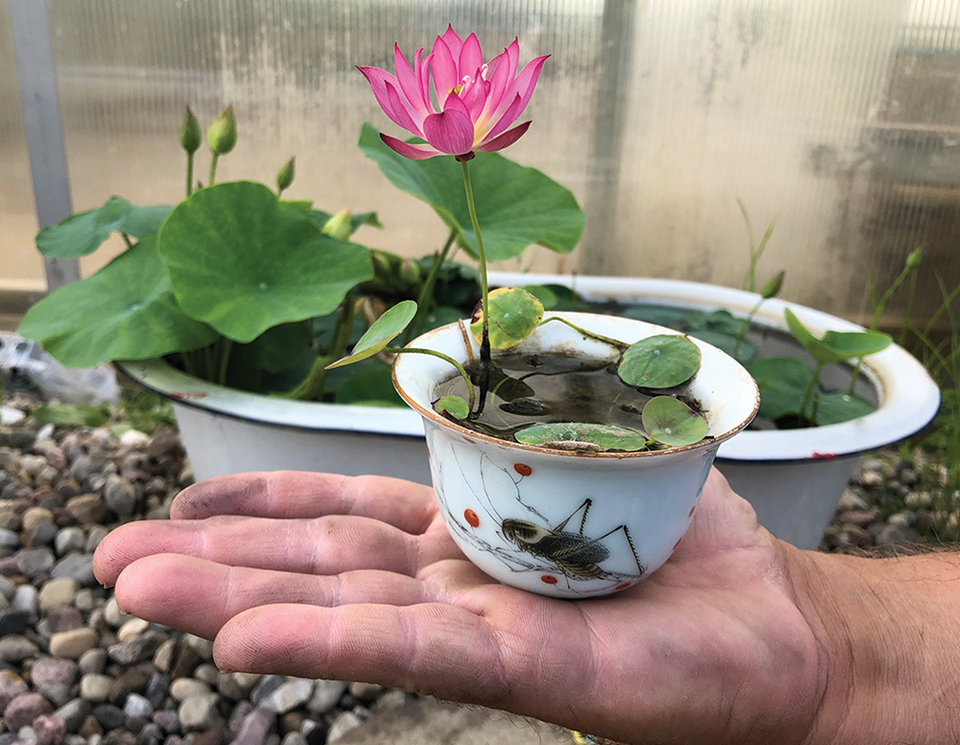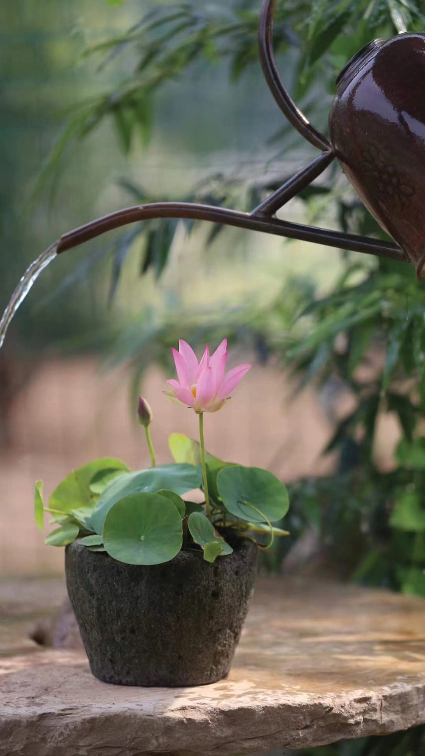
Lotus have been an integral part of Asian culture for thousands of years. Whether grown as a staple food, for their beauty or as part of religious offering, lotus is imbedded in their lives. Recent decades have seen a general migration from the rural countryside to the urban areas, often into 30-story high-rise apartments.
Lotus culture has become much more challenging now. Often balconies are part of these apartments, so this is where plants like lotus are now grown. Full-size, potted lotus is an option, but heavy, awkward pots become a chore. Smaller, petite lotus grown in decorative pots are the answer!
Evolution of Micro Lotus

Traditionally, bowl lotus, which are grown in smaller pots about 12 inches in diameter and 6 inches deep, have been popular around the world. Bowl lotus are suitable to be grown on an apartment balcony with limited space. Over the past several decades, there have been a few Chinese lotus hybridizers working to dwarf the overall size of lotus plants.
Their efforts have evolved into the creation of the micro lotus, a lotus that is very small in size. Micro lotus may be grown in pots that are 4 to 6 inches in diameter and only 2 to 3 inches deep. Their overall size is only 8 to 10 inches tall, with leaves about 2 to 4 inches in diameter. The tiniest plants grow in small teacups, with leaves only 4 inches tall and very small flowers.
Micro lotus can be a challenge to grow. First, they are very small and not always vigorous growers. With such a small volume of water covering the soil, the pots quickly dry out. Growers will often take these small pots and place them in a larger container of water. This helps not only to keep the plant hydrated but also prevents the sun from overheating the small volume pot.
Like their larger cousins, micro lotus needs to be grown outside in full sun with good air movement. At this time, micro lotus is not suitable to be grown in indoor terrariums. As advances are made in the development of LED plant lighting, growing indoors may become an option in the future. Lotus still demands hot and humid growing conditions, so indoor culture will always be a challenge. Lotus also attracts aphids; this is especially an issue in an indoor environment.
Tips for Healthy Flowers

Lotus are heavy feeders, so fertilizing is important. We feed our plants every 10 to 14 days with ¼ tab of Pondtabbs Aquatic Plant fertilizer. We start with the first standing leaf and stop feeding the first of September. Too much fertilizer will burn the leaves. Remember, there is a small volume of soil, so less fertilizer more often is the best course to follow. Some micro lotus do not produce standing leaves, so we start fertilizing by the fourth floating leaf.

Due to their diminutive size, micro lotus may only produce two to five flowers in a season. For most growers this is not an issue, as the leaves and the general aesthetics of the micro lotus plant is reward enough. Most varieties do not produce seed due to their small size. Unfortunately, the internet is riddled with false ads offering micro lotus seed — these are normal lotus! With so few seeds produced, most growers will germinate the seeds themselves to try to increase their offerings in the future.
Like all named lotus varieties, to be true to name, lotus tubers must be purchased to get the correct variety with its particular growing and flower characteristics. Micro lotus tubers are small, often only 2 to 3 inches long and very thin — about the diameter of a pencil. Some varieties do not produce a defined tuber, but rather thickened runners; these might be 6 inches long. The tiniest micro lotus are started from the side tubers of a main micro tuber, likely only 1 or 2 inches long. These are the tubers suitable for small teacups. However, we experience a 50% failure rate when we start these, as they are just so small!
Micro lotus are grown in topsoil, which is primarily clay. Any soil with added compost or peat becomes a floating mess. We have grown micro lotus in commercial aquatic planting media with satisfactory results, but we still prefer to mix in some topsoil as well. We lay the tuber on the soil and pour a bit more over the top and anchor it down. Care must be taken when handling these small tubers, as they snap easily.
We start the smallest pots in a larger container of water, with just an inch or two covering the soil. The first floating leaf should be present within 10 days. Some varieties of micro lotus will never produce standing leaves. The pot surface will be covered with floating leaves, and the flower will randomly pop up. Others will grow in a traditional fashion, with a flower accompanying a new standing leaf.
Our Micro Favorites

One of the first micro lotus we imported is still one of our favorites: N. Colorful Lantern in Qinhuai. Colorful Lantern is red with a yellow center. It is a reliable bloomer, even in the smallest of pots. It is usually the first to bloom and often produces its final flowers of the season in mid-September.
N. Cong Ke is another micro favorite. It features pink tips, with pink fading through the petals. A new offering for 2024 is N. Delicate Hand Lotus. This is a single petal pink micro lotus which generally does not produce standing leaves. Another new introduction for 2024 is N. Qian-Shuimei Lotus. Qian-Shuimei produces an exceptionally large flower for a micro lotus, which is white with purple tips.
As a guide, micro lotus will not grow large when potted in a traditional 17-inch pot. The plant will run throughout the pot, but the leaves stay small and rarely grow taller than 8 inches. In contrast, there are standard lotus which may be grown as bonsai or dwarfed by limited space. Two commonly dwarfed varieties by us are N. Autumn in Moling and N. Feicui. Both will grow small, but not as petite as a micro lotus. To achieve this feat, the smallest of tubers must be located (a 2 or 3-inch tuber versus a standard 6-to-8-inch tuber). Due to the stress of growing in a micro pot, they only produce one or two flowers during the season. Whereas grown in a standard 17-inch pot, both are excellent bloomers throughout the season. A true micro lotus is much different from a lotus, which is grown in bonsai conditions.
Micro lotus are an exciting and challenging addition to our aquatic plant community. They offer a small, manageable plant that can be grown in a limited space and does not require a pond. Their beauty is not only limited to their flowers; they also have fascinating leaves and are often grown in ornate pots.
Compared to standard lotus, the micro lotus hobby is still in its infancy. We look forward to creating and introducing many new and exciting varieties in the future!
About the Author
Larry Nau is the founder of Bergen Water Gardens which focuses on aquatic plants, koi and supplies. New opportunities were created after serving on the International Waterlily and Water Gardening Society’s board of directors and as their executive director. Starting in 2013 Larry, along with
his soon-to-be wife Lili, imported lotus tubers from China to the U.S. Lotus is now the focus of their business. They have made key introductions,
like the China Red series, the first variegated lotus, the Black Lotus and, of course, micro lotus.

